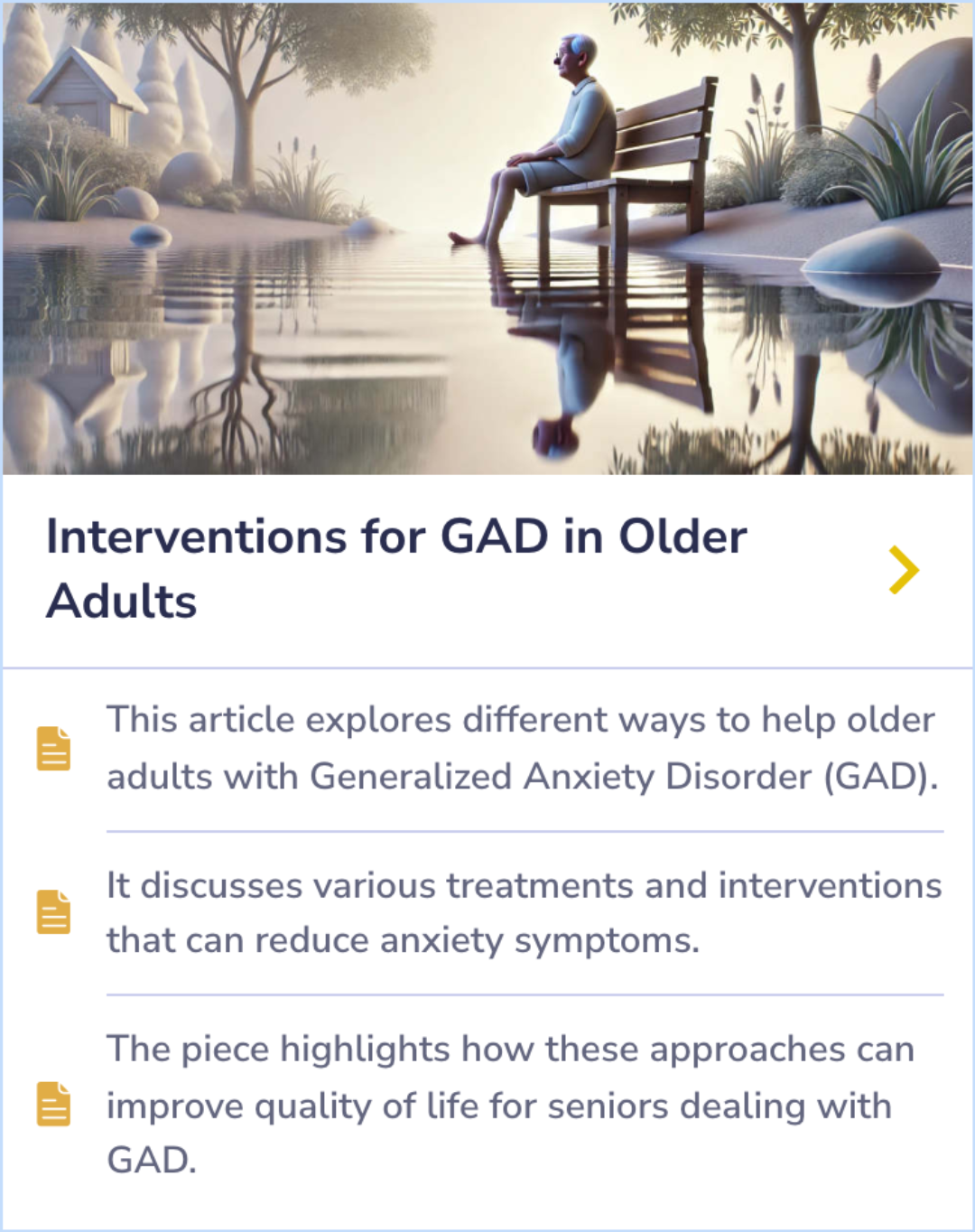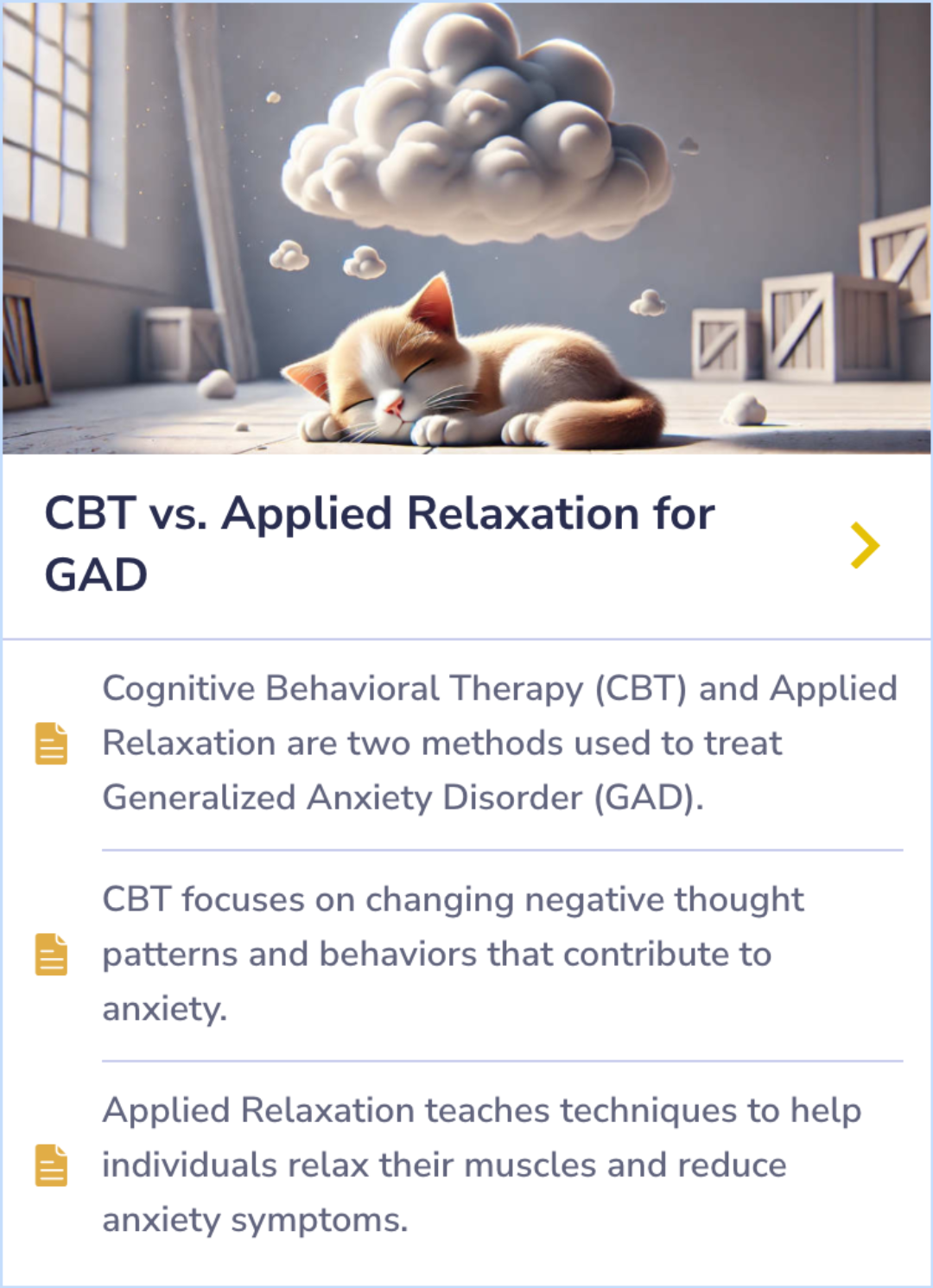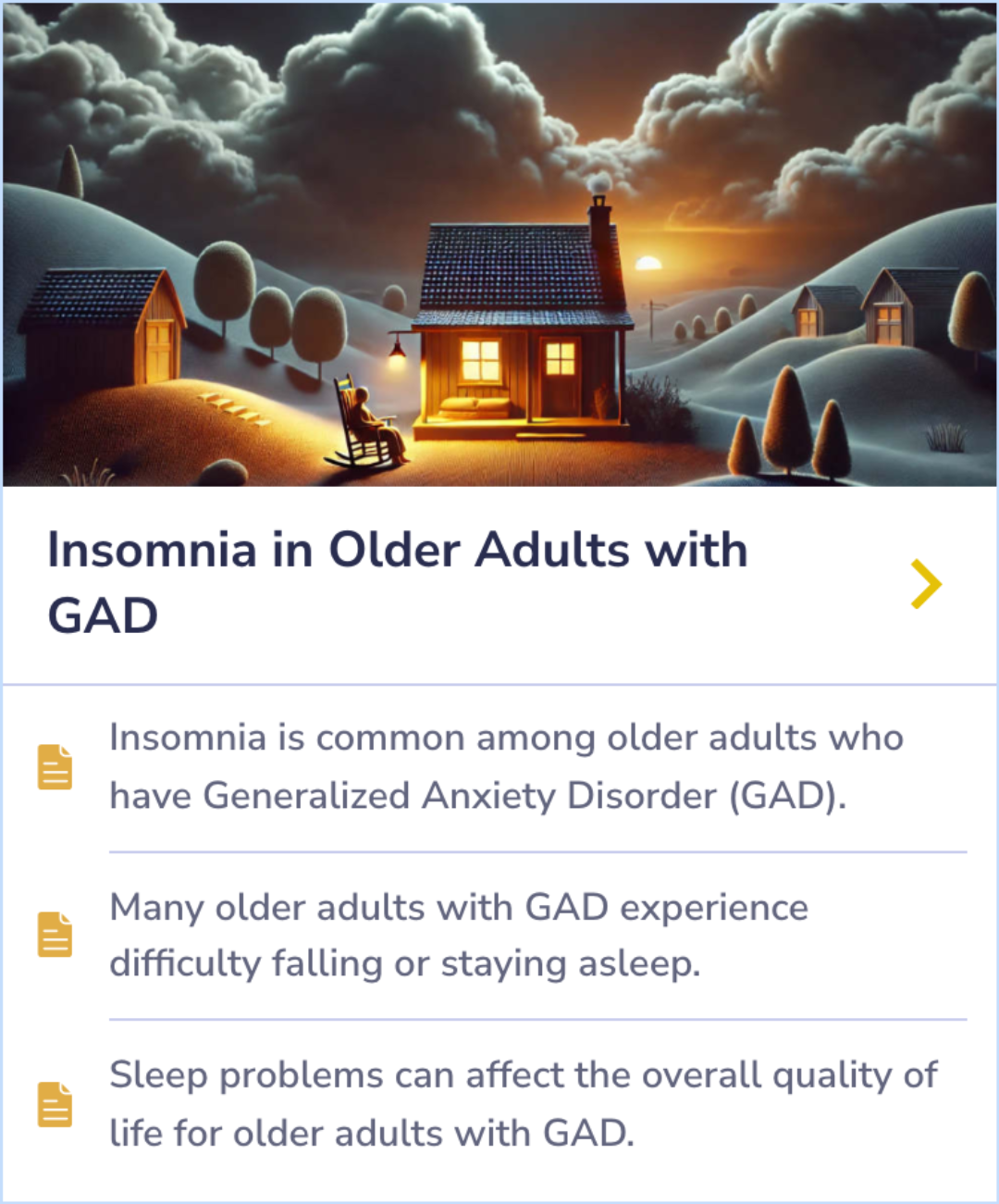Generalized Anxiety Disorder
Evidence Based Answers
Does GAD get better with age?
Generalized Anxiety Disorder (GAD) often persists over time, with older adults experiencing slight symptom reduction but continued challenges. Recovery rates are variable, with a significant portion experiencing relapses. Older adults may respond less to therapy.
Click to explore a section:
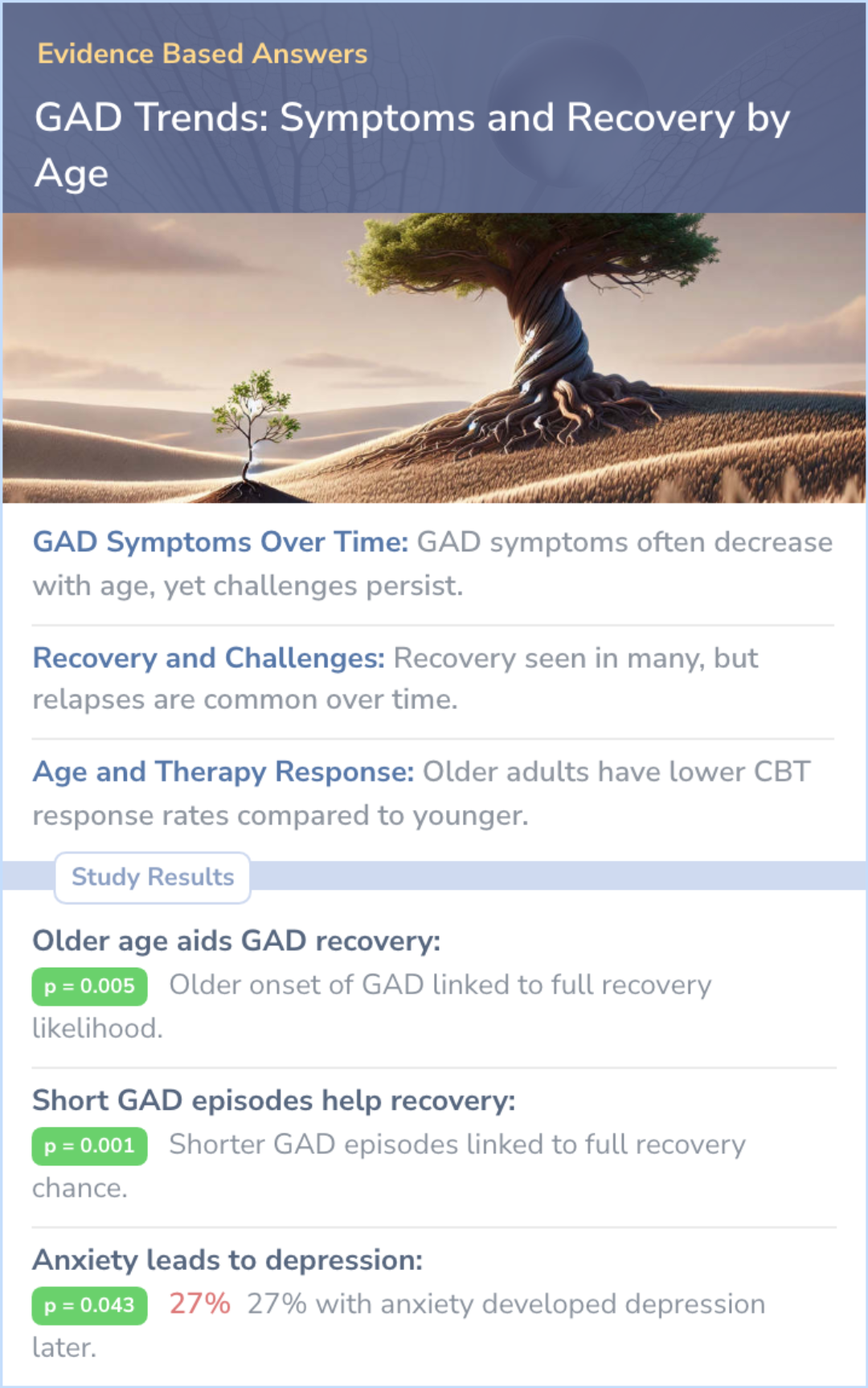
GAD's persistence and impact on age-related recovery and treatment response.
Studies Summary
🔄
Recovery Possibilities in GAD
Recovery from Generalized Anxiety Disorder is possible, with some individuals experiencing significant relief, but relapses are common.
🔑
Influence of Age on GAD Symptoms
GAD symptoms may decrease slightly with age, but older adults continue to face daily challenges, with ongoing concerns about health and family.
⚠️
Impact of Comorbid Conditions
Presence of comorbid depression significantly reduces the likelihood of recovery from GAD and increases the risk of relapse.
Highly Cited Studies
Long term Effects of Methylphenidate in Adults
Peer Reviewed Study 1
Does Anxiety Affect Mortality Risk Over Time?
Peer Reviewed Study 2
Does Anxiety Improve With Age?
Peer Reviewed Study 3
How Age and Other Factors Affect GAD Recovery
Peer Reviewed Study 4
Does Generalized Anxiety Improve Over Time?
Personal Experiences
Perspectives: Does Anxiety Improve with Age?
When it comes to anxiety and aging, views vary widely. Some individuals find their anxiety worsening due to life responsibilities, health worries, or unresolved issues, while others report improvements through proactive efforts like therapy, exercise, and self-awareness.
The discussion highlights the importance of individual experiences, coping strategies, and the role of external factors like societal pressures in shaping anxiety over time.
The discussion highlights the importance of individual experiences, coping strategies, and the role of external factors like societal pressures in shaping anxiety over time.
Reddit: u/christineyvette
As we grow older, it seems like we have more responsibilities, and we see things for what they are. Maybe we either have more things to be anxious about, or our old issues haven't been worked through.Background: Does GAD Improve Over Time?
Generalized Anxiety Disorder (GAD) is often a long-term condition where symptoms can come and go. Some individuals may experience periods of improvement, but symptoms frequently return over time.
Older adults might see slight decreases in symptom severity. However, many continue to face challenges in daily life, including work and social activities.
Older adults might see slight decreases in symptom severity. However, many continue to face challenges in daily life, including work and social activities.
“
Source Quotes:
GAD tends to be a persistent illness with fluctuating symptom severity. It is associated with substantial psychosocial impairment including occupational, social, and household functioning.
In a group of older people with GAD who still remained symptomatic, the mean duration of the illness was 37 years.
Background: Recovery and Relapse in GAD
Recovery from GAD is possible, with some studies reporting that up to 60% of individuals experience significant relief over long periods. However, many of these individuals experience relapses later on.
Consistent management can help maintain recovery, though complete remission remains uncommon.
Consistent management can help maintain recovery, though complete remission remains uncommon.
“
Source Quotes:
Approximately 60 percent of patients recovered over 12 years, but approximately one-half of recovered patients subsequently relapsed during the 12-year period.
A study that followed GAD patients, most of whom received treatment, over 22 years found that 63% had been symptom free for at least one year at the time of follow-up.
Background: Age and Symptom Severity in GAD
GAD symptoms tend to decrease slightly with age, but it remains a common condition among older adults. Late-onset GAD, beginning at age 50 or later, often involves concerns about health or family.
Younger adults typically experience more intense symptoms, focusing on work or social issues. These patterns reflect how life stage influences anxiety triggers.
Younger adults typically experience more intense symptoms, focusing on work or social issues. These patterns reflect how life stage influences anxiety triggers.
“
Source Quotes:
The severity of anxiety symptoms over time decreased only modestly.
Younger adults experience greater severity of symptoms than do older adults.
Background: Challenges in Treating GAD in Older Adults
Older adults with GAD often have lower response rates to Cognitive Behavioral Therapy (CBT) compared to younger individuals. For example, only 40% of older adults in some studies responded to CBT.
Group CBT shows potential for improving outcomes by encouraging connection and emotional support among participants.
Group CBT shows potential for improving outcomes by encouraging connection and emotional support among participants.
“
Source Quotes:
Responses to CBT among older adults may be lower compared to younger adults. For example, in late-life samples with generalized anxiety disorder (GAD) treated with CBT in primary care, only 40 percent of the intent-to-treat sample was classified as responders compared with an average of 56 percent response rate found in trials of non-late-life samples.
For older patients, we are more likely to suggest group treatment because this format encourages interaction with others and opportunities for self-disclosure.
Background: Course
The development and progression of Generalized Anxiety Disorder (GAD) vary by age. The median onset is at 30 years, with symptoms often beginning in childhood or adolescence. GAD tends to follow a chronic course with periods of increased and decreased severity.
There are also age-related differences in focus: children often worry about school and performance, while older adults may become more concerned with health and family issues. These changes highlight how GAD may manifest differently over the lifespan.
There are also age-related differences in focus: children often worry about school and performance, while older adults may become more concerned with health and family issues. These changes highlight how GAD may manifest differently over the lifespan.
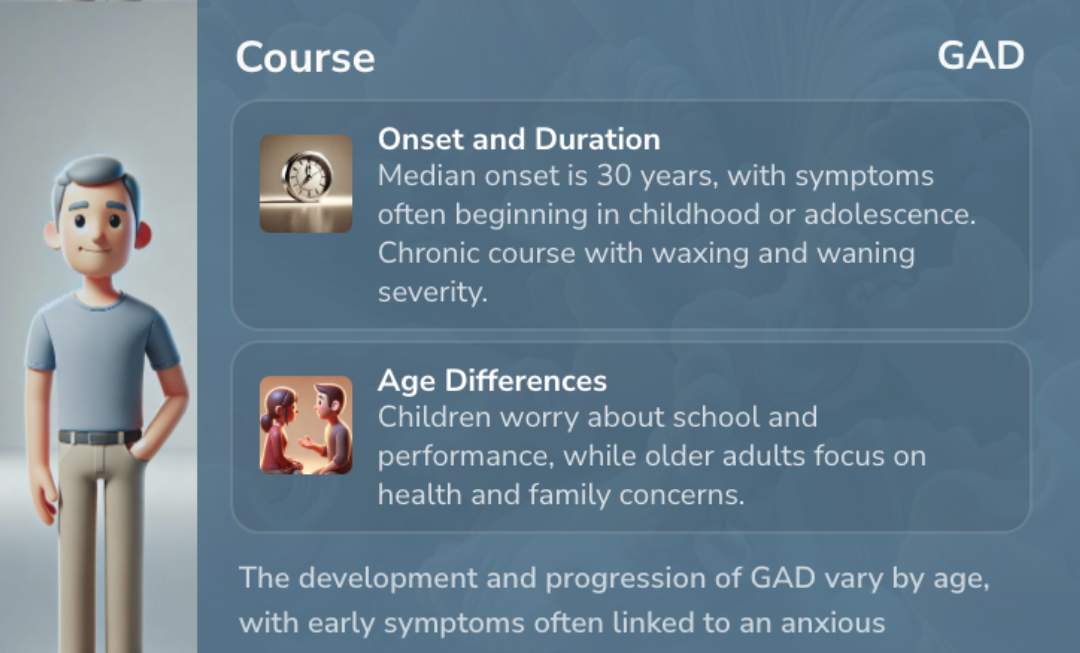
Peer Reviewed Study
Study: Does Anxiety Affect Mortality Risk Over Time?
Generalized anxiety disorder does not appear to significantly increase the risk of death in adults, regardless of age or sex.
Similarly, individuals with mixed anxiety and depression also show no higher risk of death, suggesting stability in outcomes over time.
These findings indicate that age-related outcomes for anxiety may not worsen significantly in terms of mortality risk.
Similarly, individuals with mixed anxiety and depression also show no higher risk of death, suggesting stability in outcomes over time.
These findings indicate that age-related outcomes for anxiety may not worsen significantly in terms of mortality risk.
author
Holwerda TJ, Schoevers RA, Dekker J, Deeg DJ, Jonker C, Beekman AT
journal
Int J Geriatr Psychiatry
Date Published
2007 Mar
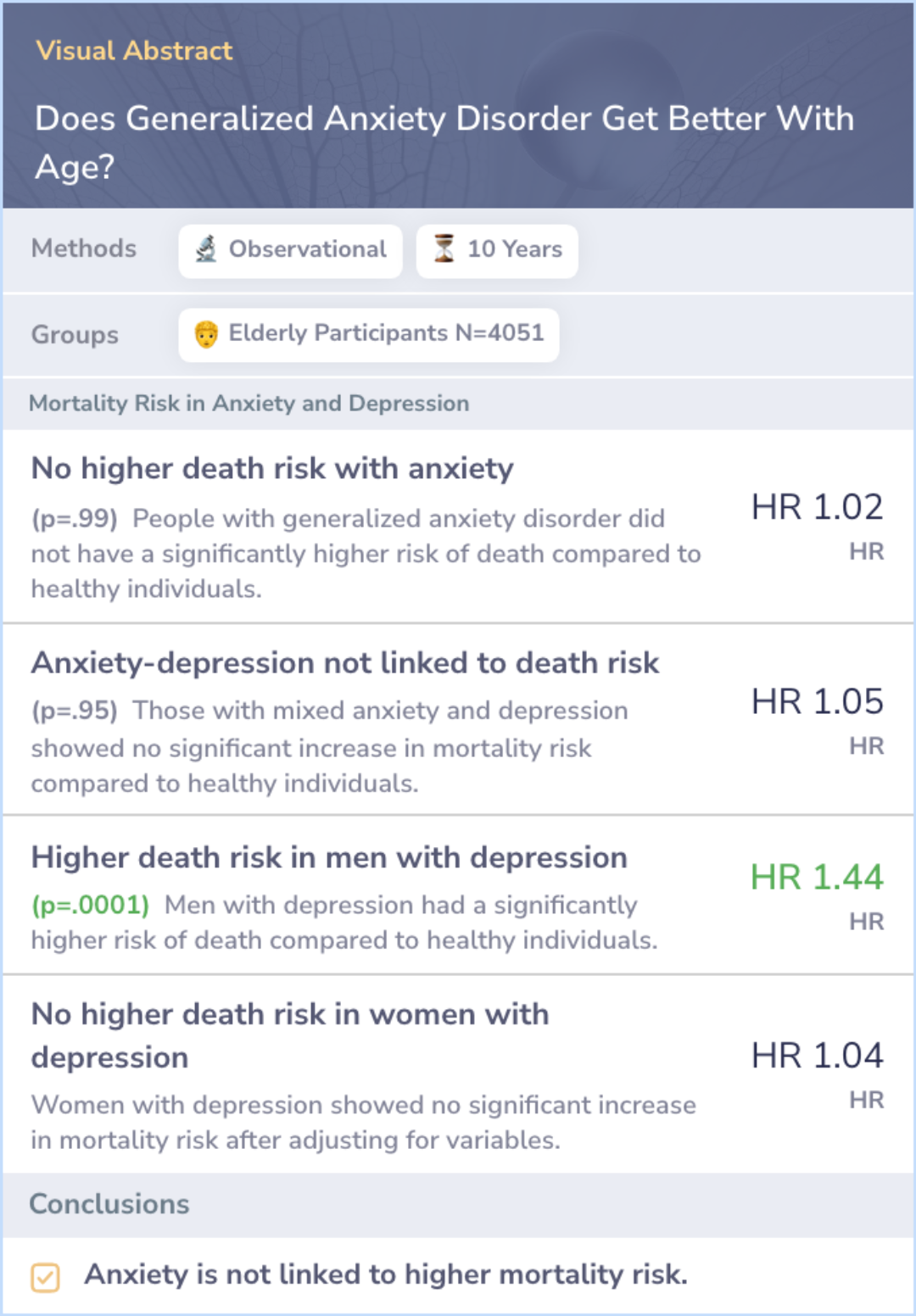
Peer Reviewed Study
Study: Does Anxiety Improve With Age?
Research shows that 48% of people with generalized anxiety disorder recover over time.
However, recovery rates drop to 27% when anxiety is combined with depression. Additionally, 27% of people with anxiety develop depression over time.
Chronic illnesses further increase the risk of anxiety and depression, nearly tripling the likelihood of developing these conditions.
However, recovery rates drop to 27% when anxiety is combined with depression. Additionally, 27% of people with anxiety develop depression over time.
Chronic illnesses further increase the risk of anxiety and depression, nearly tripling the likelihood of developing these conditions.
author
Schoevers RA, Deeg DJ, van Tilburg W, Beekman AT
journal
Am J Geriatr Psychiatry
Date Published
January 2005
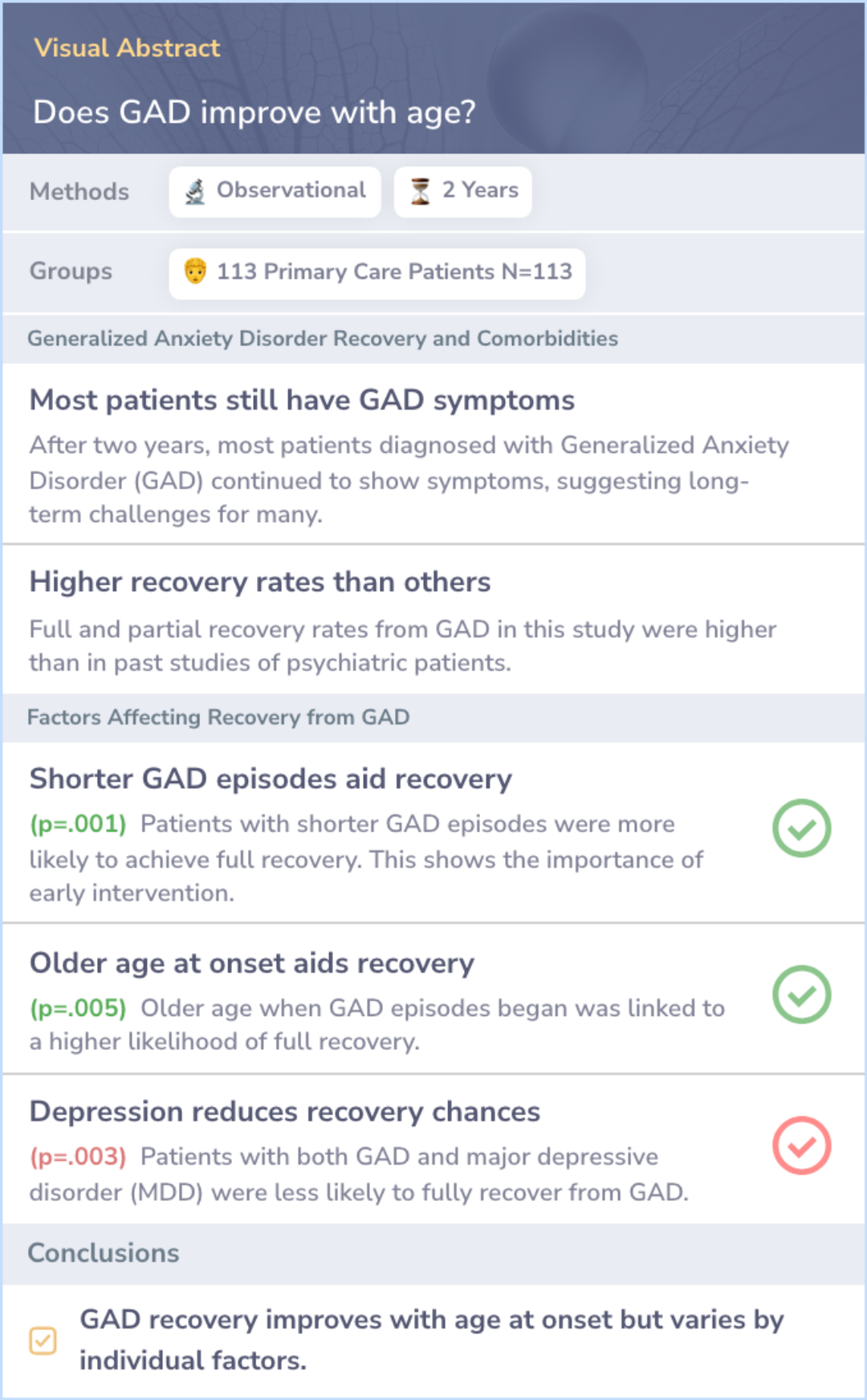
Peer Reviewed Study
Study: How Age and Other Factors Affect GAD Recovery
Generalized Anxiety Disorder (GAD) recovery varies widely. Most patients remain symptomatic for years.
Older age at onset and shorter episodes increase the chances of full recovery.
Comorbid depression significantly reduces recovery likelihood.
Older age at onset and shorter episodes increase the chances of full recovery.
Comorbid depression significantly reduces recovery likelihood.
author
Rodriguez BF, Weisberg RB, Pagano ME, Bruce SE, Spencer MA, Culpepper L, Keller MB
journal
J Nerv Ment Dis
Date Published
2006 Feb

Peer Reviewed Study
Study: Does Generalized Anxiety Improve Over Time?
Research shows that generalized anxiety disorder (GAD) has a low recovery rate, with only 58% recovering over 12 years. Social anxiety had even worse outcomes, with a recovery rate of 37%.
Factors like comorbid depression further reduce recovery chances and increase relapse risks.
Factors like comorbid depression further reduce recovery chances and increase relapse risks.
author
Bruce SE, Yonkers KA, Otto MW, Eisen JL, Weisberg RB, Pagano M, Shea MT, Keller MB
journal
Am J Psychiatry
Date Published
2005 Jun
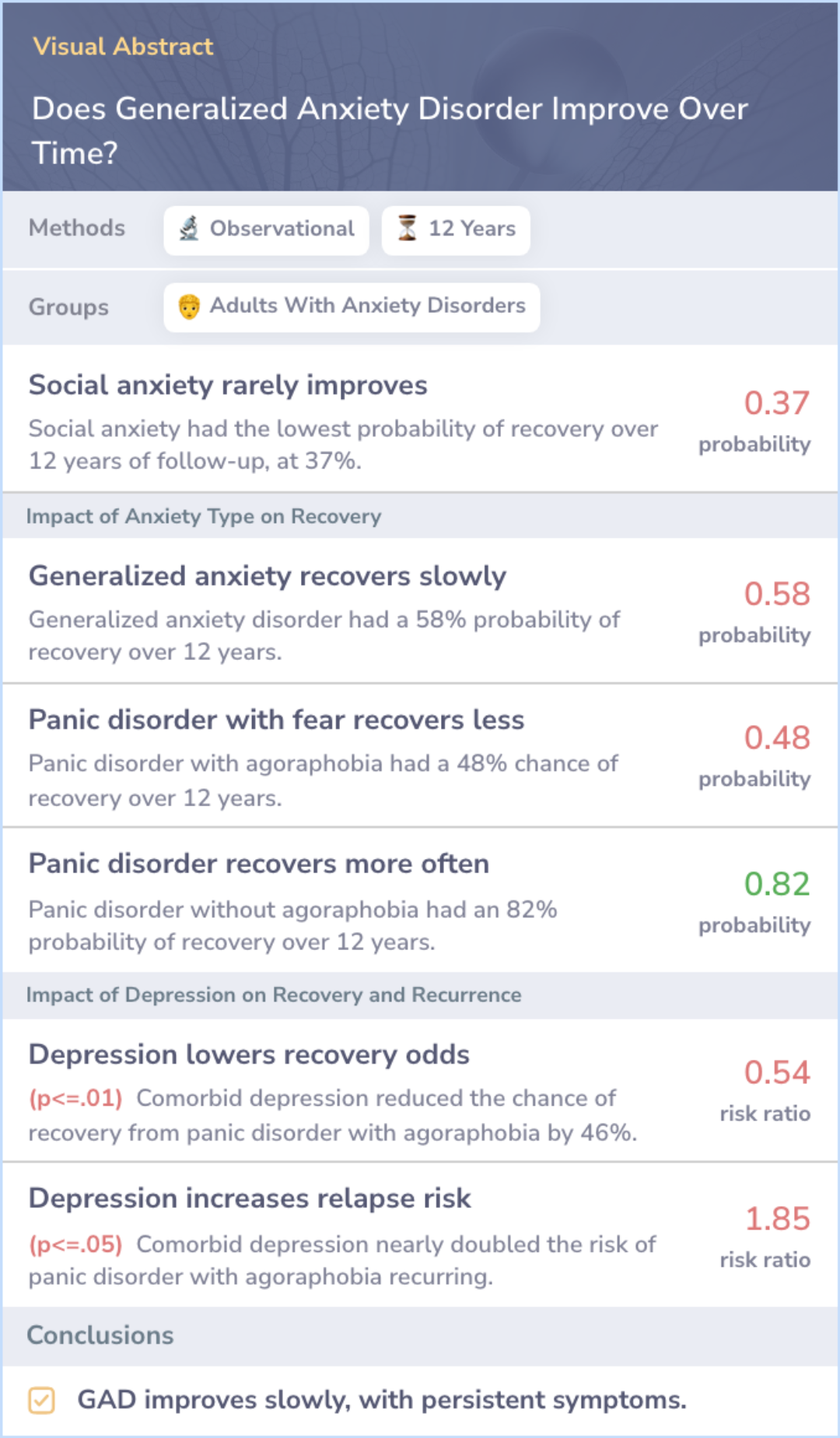
Key Takeaways
Conclusions
Generalized Anxiety Disorder (GAD) presents a complex pattern across the lifespan. Studies show a significant variability in recovery, with older onset age and shorter episodes offering better odds for improvement. Yet, GAD symptoms are often persistent, and complete remission is rare.
Though symptom severity may slightly decrease with age, consistent management is vital as relapse is common. GAD does not increase mortality risk significantly, but other conditions like depression can worsen outcomes, highlighting the ongoing challenge it presents across age groups.
Though symptom severity may slightly decrease with age, consistent management is vital as relapse is common. GAD does not increase mortality risk significantly, but other conditions like depression can worsen outcomes, highlighting the ongoing challenge it presents across age groups.
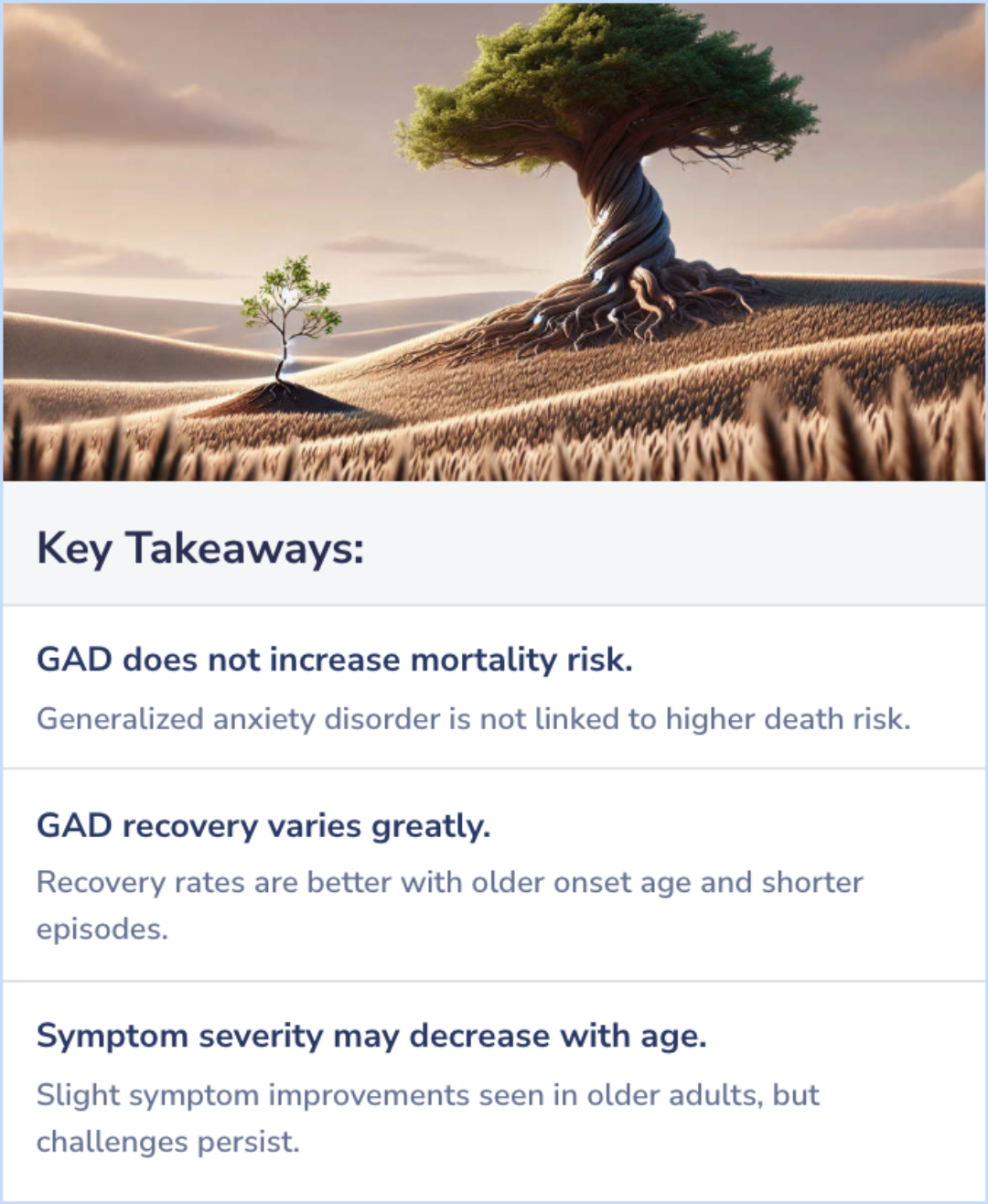
Evidence Summary
Reducing Anxiety and Improving Life for Seniors with GAD
Exploring how various treatments can reduce anxiety symptoms, the article details effective methods aimed at improving life quality for older adults with Generalized Anxiety Disorder (GAD).
These approaches address both emotional and physical aspects of anxiety, helping seniors find relief and improve well-being as they navigate the challenges of GAD.
These approaches address both emotional and physical aspects of anxiety, helping seniors find relief and improve well-being as they navigate the challenges of GAD.
Evidence Summary
Transforming Anxiety: Two Effective Approaches
Cognitive Behavioral Therapy (CBT) offers a structured approach to tackling anxiety by transforming negative thought patterns and behaviors, providing individuals with tools to challenge their anxious thoughts. In contrast, Applied Relaxation emphasizes physical techniques that promote muscle relaxation, helping to ease anxiety symptoms through controlled breathing and relaxation exercises.
Both methods provide distinct strategies for managing Generalized Anxiety Disorder (GAD), catering to different preferences and therapeutic needs, highlighting the varied ways to address anxiety effectively.
Both methods provide distinct strategies for managing Generalized Anxiety Disorder (GAD), catering to different preferences and therapeutic needs, highlighting the varied ways to address anxiety effectively.
Evidence Summary
Sleep Struggles in Older Adults with GAD
Insomnia is a frequent challenge for older adults with Generalized Anxiety Disorder, making it harder to fall or stay asleep. This struggle directly impacts their daily lives and overall well-being.
Difficulty sleeping adds to the burden of living with GAD, further reducing quality of life for many older adults. These challenges highlight the interplay between mental health and sleep in aging populations.
Difficulty sleeping adds to the burden of living with GAD, further reducing quality of life for many older adults. These challenges highlight the interplay between mental health and sleep in aging populations.
